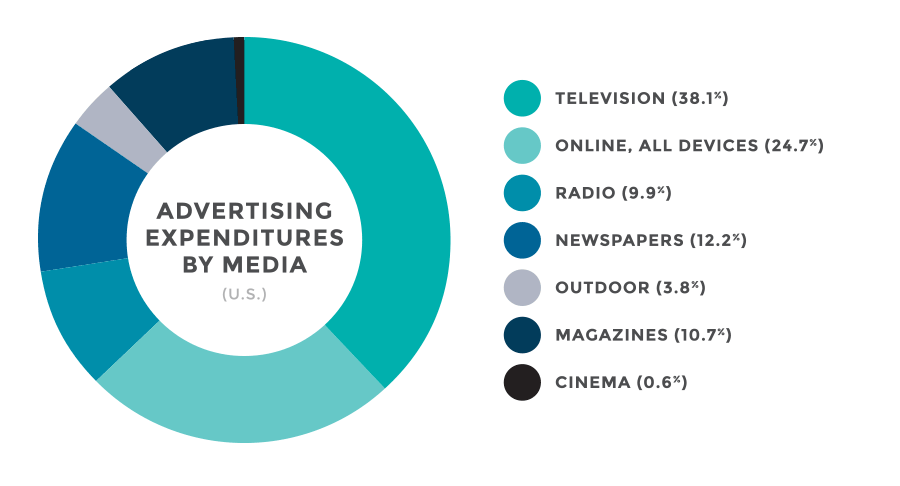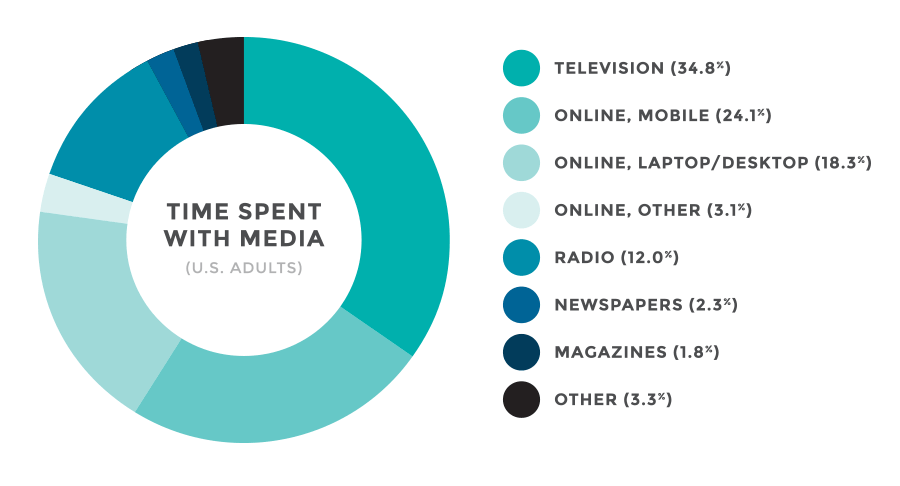Let’s be honest—how many videos have you watched today? No judgment. We’re all in the same boat. Reels, TikToks, Shorts...

Adapt Marketing to Match Consumer Behavior
The “Eyeball-to-Spend Gap”
There’s a phrase that aptly describes the disconnect between where today’s consumers spend their time and where marketers spend their money: it’s called the “eyeball-to-spend gap.” And it could mean the difference between effectively and efficiently reaching your audience with ad dollars or wasting those dollars on channels that aren’t getting enough eyeballs on them.
Let me explain. Here’s the average share of “eyeballs” (and ears) each medium gets per day among U.S. adults as of October 2015:
And here’s how U.S. advertising expenditures are forecast to be allocated by medium in 2015:
Advertising Expenditures by Media – U.S.
A quick glimpse at these numbers reveals that advertisers have not caught up to consumers in terms of the shift to digital. We spend more than 45 percent of our time online—about 5.5 hours a day, that is—but advertisers give digital less than 25 percent of their dollars. Break this down even further and you see even more of a gap: while U.S. adults’ media time spent online via a mobile device is around 24 percent, mobile ad spend is just 8 percent.
It’s clear that marketers need to respond, but it’s not as simple as just shifting dollars to align with consumer consumption patterns. Instead, marketers need to begin by taking a close look at the factors that have led to this gap, which include:
Over-reliance on past practice
This isn’t a marketing problem; it’s a human nature problem. Most of us don’t like change and as a result we are slow to adapt. In short, it’s easier to do what we’ve always done because we know how to do it. Even when those actions are no longer effective, we may stick with them because they’re comfortable.
Over-reliance on more familiar media
This is an old problem among marketers: we tend to use our own habits as an indicator of larger trends. This gets even more problematic when you consider that the next generation of consumers’ media consumption habits are markedly different than that of any generation that’s come before. If we rely upon our own experience with media, the gap will widen quickly.
Concerns of advertising effectiveness in the digital space
It’s certainly wise to consider how messages need to adapt when developed for a 30-second television spot, for example, as compared to a mobile display ad. However, the fact you don’t like the latter because it’s only 50 pixels high will not change consumer trends. We need to adapt to the medium instead of wishing consumers would reverse course.
It’s also important to consider one of the primary reasons why consumers are migrating to digital media: quite simply, it’s more customized to their needs. Unlike traditional media, which attempts to reach mass audiences, digital media consumption is much more fragmented. Now more than ever, we consume exactly what we want, exactly when and where we want it. In addition, the shift to digital represents the consumer’s desire to move their eyeballs and ears away from advertising—or at least advertising that doesn’t take their individual needs into consideration.
Smart marketers must, therefore, do more than just allocate more budget dollars toward digital. They must also look beyond the averages to consider specific target audience demographics—age, gender, race, income, and other factors—knowing that media consumption habits vary greatly among different groups. In addition, they must listen to what consumers seem to be saying about advertising in general and serve up messages that are better crafted, look less like traditional advertising, are more authentic, and—most importantly—that put the audience’s needs first. Finally, they must take advantage of data, ensuring that their messages are more relevant to the audience’s needs on the front end and taking time on the back end to measure what works and adapt as needed.
More than anything else, however, marketers must also get comfortable with discomfort, knowing the only way to keep pace with the consumer is to avoid complacency and commit to ongoing learning. Today’s eyeball-to-spend gap, after all, demonstrates not just how far behind we’ve fallen, but the potential for consumers to get even further away in the future. The only way to catch up is to get moving—now.
Written by Anthony Juliano, Asher Agency Vice President, General Manager
More of our thoughts
Culture isn’t something written on a wall — it’s something you feel the moment you walk through our doors or jump on a call with our team.
The A-Team headed southwest to attend the Restaurant Leadership Conference and join industry leaders from across the country.




